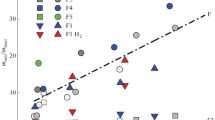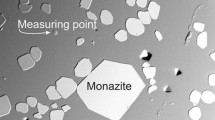Abstract—
The major objective of the study investigation was to find the physicochemical conditions for U, Nb, and Ta mobilization into the solution from acidic melts similar in composition to rhyolitic inclusions in quartz at the unique Streltsovka Mo–U field (Eastern Transbaikalia). The experiments were performed with model homogeneous leucogranite glass (wt %): 72.18 SiO2, 12.19 Al2O3, 1.02 FeO, 0.2 MgO, 0.33 CaO, 4.78 Na2O, 3.82 K2O, 1.44 Li2O, and 2.4 F (LiF, NaF, KF, CaF2, and MgF2); synthetic uranium dioxide; and natural columbite in solutions containing from 1 to 8 mol kg–1 chlorides (Na, K, and Li) at 750°C, 1000 bar, with an O2 (H2) fugacity set by the Ni–NiO buffer. The selected T–P parameters and solutions corresponded to the homogeneous and fluid immiscibility regions in the NaCl–KCl–H2O solutions. The Nb and Ta contents in the Cl–F solutions in equilibrium with F-bearing melts are very low. The U content is much higher and reaches about 1 × 10–4 wt % in the low-density fluid phase and n × 10–3 wt % in the dense aqueous saline phase (brine). The U content in the glass was tenths of a percent. Despite the very high chlorine content in the studied solutions, its content did not exceed 0.5 wt % in the glass. In the course of the experiments, columbite dissolved incongruently in the glass melt to form F- and U-bearing pyrochlores. According to the investigation results, the predominantly chloride fluid with the studied T–P parameters should not be considered an active medium for mobilization of U from Li–F granite melts in the formation of unique hydrothermal U (Mo–U) deposits.







Similar content being viewed by others
REFERENCES
Aleshin, A.P., Velichkin, V.I., and Krylova T.L. Genesis and formation conditions of deposits in the unique Strel’tsovka molybdenum–uranium ore field: new mineralogical, geochemical, and physicochemical evidence, Geol. Ore Deposits, 2007, vol. 49, no. 5, pp. 392–412.
Anderko, A. and Pitzer, K.S., Phase equilibria and volumetric properties of the systems KCl–H2O and CaCl–KCl–H2O above 573 K: equation of state representation, Geochim. Cosmochim. Acta, 1993, vol. 57, pp. 4885–4897.
Arana, G., Etxebarria, N., Fernandez, L.A., and Madariaga, J.M., Hydrolysis of Nb(V) and Ta(V) in aqueous KCl at 25°C. Part II: construction of a thermodynamic model for Ta(V), J. Solution Chem., 1995, vol. 24, pp. 611–622.
Babko, A.K., Lukachina, V.V., and Nabivanets, B.I., Solubility and acid-base properties of tantalum and niobium hydroxides, Russ. J. Inorg. Chem., 1963, vol. 8, pp. 957–961.
Badanina, E.V., Syritso, L.F., Volkova, E.V., Thomas, R., and Trumbull, R.B., Composition of Li–F granite melt and its evolution during the formation of the ore-bearing Orlovka massif in eastern Transbaikalia, Petrology, 2010, vol. 18, no. 2, pp. 131–157.
Borodulin, G.P., Chevychelov, V.Yu., and Zaraisky, G.P., Ta and Nb partitioning between aqueous fluid and acid melts with different content of aluminum and alkalis at T = 650–850°C and P = 100 MPa, Elektron. Nauch.-Inf. Zh. Vestn. Otd. Nauk Zemle RAN, 2007, no. 1 (25).
Calas, G., Etude experimentale du comportement de l’uranium dans les magmas, etats d’oxydation et de coordinance, Geochim. Cosmochim. Acta, 1979, vol. 43, pp. 1521–1531.
Chabiron, A. and Cuney, M., Alteration de l’allanite dans les granites sous la caldeira de streltsovka (transbaikalie, russie). une source possible d’uranium pour les gisements, C. R. Acad. Sci. Paris, Sciences de la Terre et des Planets, 2001, no. 332, pp. 99–105.
Chabiron, A., Alyoshin, A.P., Cuney, M., Deloule, E., Golubev, V.N., Velitchkin, V.I., and Poty, B., Geochemistry of the rhyolitic magmas from the Streltsovka Caldera (Transbaikalia, Russia): a melt inclusion study, Chem. Geol., 2001, vol. 175, pp. 273–290.
Chabiron, A., Cuney, M., and Poty, B., Possible uranium sources for the largest uranium district associated with volcanism: the Streltsovka Caldera (Transbaikalia, Russia), Miner. Deposita, 2003, no. 38, pp. 127–140.
Chevychelov, V.Yu., Chlorine Dissolution in Fluid-rich Granitic Melts: The Effect of Calcium Addition, Geochem. Int., 1999, vol. 37, no. 5, pp. 456–467.
Chevychelov, V.Yu., Zaraisky, G.P., and Borodulin, G.P., Experimental study of the influence of alkaline melt, temperature, and pressure on the solubility of trace metals, (Ta, Nb) in a granitoid melt, Sb.: Shchelochnoi magmatizm Zemli i ego rudonosnost': Mater. mezhdunar. Soveshch. (Proc. International Conference on the Alkaline Magmatism of the Earth and its Ore Potential), Kiev, 2007, pp. 259–263.
Cygan, G.L., Hemley, J.J., Doughten, M.W. Fe, Pb, Zn, Cu, Au, and HCl partitioning between vapor and brine in hydrothermal fluids-implications for porphyry copper deposits, USGS Research on Mineral Deposits. Part A, 9th V.E. McKelvey Forum, USGS Circular, 1994, no. 1103-A, pp. 26–27.
Dubois, M., Weisbrod, A., and Shtuka, A., Experimental determination of the two-phase (liquid and vapour) region in water-alkali chloride binary systems at 500 and 600°C using synthetic fluid inclusions, Chem. Geol., 1994, vol. 115, pp. 227–238.
Hemley, J.J. and Jones, W.R., Chemical aspects of hydrothermal alteration with emphasis on hydrogen metasomatism, Econ. Geol., 1964, vol. 59, no. 4, pp. 538–569.
Kamenetsky, V.S., Naumov, V.B., Davidson, P., van Achterbergh, E., and Ryan, C.G., Immiscibility between silicate magmas and brines in the Omsukchan granite (NE Russia): melt inclusion probe into magmatic–hydrothermal transition, Chem. Geol., 2004, vol. 210, nos. (1–4), pp. 73–90.
Keppler, H. and Wyllie, P.J., Role of fluids in transport and fractionation of uranium and thorium in magmatic processes, Nature, 1990, pp. 531–533.
Keppler, H. and Wyllie, P.J., Partitioning of Cu, Sn, Mo, W, U, and Th between melt and aqueous fluid in the systems haplogranite–H2O–HCl and haplogranite–H2O–HF, Contrib. Mineral. Petrol., 1991, vol. 109, pp. 139–150.
Khomich, V.G. and Boriskina, N.G., Advancement of mineragenic regionalization of Eastern Transbaikalia based on geophysical studies, Russ. Geol. Geophys., 2017, vol. 58, no. 7, pp. 822–835.
Kovalenko, N.I., Ryzhenko, B.N., Prisyagina, N.I., and Bychkova, Ya.V., Experimental study of uraninite solubility in aqueous HCl solutions at 500°C and 1 kbar, Geochem. Int., 2011, vol. 49, no. 3, pp. 262–273.
Krylova, T.L., Aleshin, A.P., Lomm, T., Velichkin, V.I., and Kyune, M., Evidence for magmatogenic origin of ore-forming fluids at the Mo–U deposits of the Streltsovka ore field (Eastern Transbaikalia, Russia), Mater. XIII Mezhdunar. konf. po termobarogeokhimii i IV APIFIS. simpoziuma (Proc. 13th Int. Conf. on Thermobarogeochemistrt and 4th APIFIS Symposium), Moscow, 2008, vol. 2, pp. 64–67.
Malinin, S.D. and Kurovskaya, N.A. The effect of pressure on mineral solubility in aqueous chloride solutions under supercritical conditions, Geochem. Int., 1996, vol. 34, no. 1, pp. 45–52.
Palliser, Ch. and McKibbin, R., A model for deep geothermal brines, I: T-p-X state-space description, Transport Porous Med., 1998, vol. 33, pp. 65–80.
Peiffert, Ch., Nguyen-Trung, Ch., and Cuney, M., Experimental determination of uranium solubility and fluid-melt partition coefficients in the uranium oxide–haplogranite–H2O–NaX (X = Cl, F) system at 770°C, 2 kbar, Geochim. Cosmochim. Acta, 1996, vol. 60, pp. 1515–1529.
Redkin, A.F., Study of U(IV) complexation in chloride solutions at 300–600°C and 1000 bar, Elektron. Nauch.-Inf. Zh. Vestn. Otd. Nauk Zemle RAN, 2009, no. 1(27).
Redkin, A.F., Study of solubility of UO2 and U(VI) hydroxides in water at high temperatures and pressure, Materialy nauchnogo seminara, posvyashchennogo nauchnoi deyatel’nosti prof., dkhn I.L. Khodakovskogo (Proc. Seminar Devoted to the Scientific Activity of Prof. L.I. Khodakovsky), Dubna, 2013, pp. 73–79.
Redkin, A.F., Influence of oxygen fugacity and temperature on the solubility and stability of uranium oxide compounds in the U–O–H system, Trudy nauchnogo seminara pamyati prof., dkhn I.L. Khodakovskogo: sbornik materialov (Proc. Seminar Devoted to the Scientific Activity of Prof. L.I. Khodakovsky), Gladyshev, P.P., Eds., Dubna: Gos. Univ. “Dubna”, 2017, pp. 162–168.
Redkin, A.F., Omel’yanenko, B.I., and Ivanov, I.P., Experimental stud of solubility of oxides and hydroxides in water and acid chloride solutions, Khimiya urana: sbornik nauchnykh trudov (Uranium Chemistry. A Collection of Papers), Laskorin, B.N., Myasoedov, B.F., Eds., Moscow: Nauka, 1989, pp. 42–54.
Redkin, A.F., Velichkin, V.I., Aleshin, A.P., and Borodulin, G.P., Interaction of model F-bearing silicic melt with chloride fluid, uraninite, and columbite at 750°C and 1000–2000 bar and its implications for estimation of the ore-forming capability of the upper crustal magma chamber beneath the Strel’tsovka Caldera, Eastern Transbaikalia, Geol. Ore Deposits, 2009, vol. 51, no. 4, pp. 290–304.
Shvarov, Yu.V., HCh: New potentialities for the thermodynamic simulation of geochemical systems offered by Windows, Geochem. Int., 2008, vol. 4, no. 8, pp. 834–839.
Shvarov, Yu., A suite of programs, OptimA, OptimB, OptimC, and OptimS compatible with the Unitherm database, for deriving the thermodynamic properties of aqueous species from solubility, potentiometry and spectroscopy measurements, Appl. Geochem., 2015, vol. 55, pp. 17–27.
Yudintsev, S.V., Study of uranium behavior in alkaline magmas, Geokhimiya, 1990, no. 4, pp. 538–544.
Yudintsev, S.V., Uraninite solubility in a water-saturated granite melt, Dokl. AN SSSR, 1986, vol. 287, no. 1, pp. 205–207.
Yudintsev, S.V. and Omel’yanenko, B.I., On the uranium behavior in a crystallizing melt, Geokhimiya, 1984, no. 4, pp. 555–559.
Zharikov, V.A., Ivanov, I.P., Omel’yanenko, B.I., Redkin, A.F., and Yudintsev, S.V., Experimental study of uraninite solubility in model granitic melts and solutions at high parameters, Geol. Rud. Mestorozhd., 1987, no. 4, pp. 3–12.
ACKNOWLEDGMENTS
We thank T.N. Shuriga (Fedorovsky All-Russian Research Institute of Mineral Resources) for the columbite, I.P. Petrov (Institute of Geology of Ore Deposits, Petrography, Mineralogy and Geochemistry, Russian Academy of Sciences) for the high-purity acids kindly placed at our disposal for analytical studies, A.A. Mukhanova (Institute of Experimental Mineralogy, Russian Academy of Sciences) for help in the X-ray spectral analysis of solid phases using VEGA TS 5130MM equipment, L.T. Dmitrenko and M.V. Fokeev for successful experiments using high hydrothermal and gas pressure equipment, A.R. Kotelnikov for discussion of the work and useful advice on the immiscibility of aqueous saline systems, and the referee for his attention to the paper and valuable comments that were taken into account in the final edition.
Funding
The study was supported by the Russian Foundation for Basic Research (project nos. 07-05-00662а, 18-05-01001а, 20-05-00307а) and the Program of the Department of Earth Sciences, Russian Academy of Sciences, and Fundamental Scientific Research of the State Academies of Sciences (project no. АААА-А18-118020590151-3).
Author information
Authors and Affiliations
Corresponding authors
Ethics declarations
The authors declare that they have no conflict of interest.
Additional information
Translated by E. Maslennikova
Rights and permissions
About this article
Cite this article
Redkin, A.F., Velichkin, V.I. Research of the Uranium, Niobium, and Tantalum Behavior in the Granite Melt–Chloride Fluid System at 750°C and 1000 Bar. Geol. Ore Deposits 62, 372–382 (2020). https://doi.org/10.1134/S1075701520050074
Received:
Revised:
Accepted:
Published:
Issue Date:
DOI: https://doi.org/10.1134/S1075701520050074




